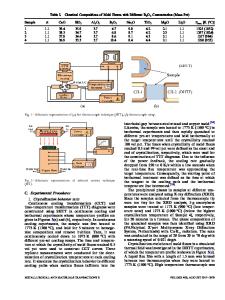Effect of Na 2 O and B 2 O 3 on the Crystallization Behavior of Low Fluorine Mold Fluxes for Casting Medium Carbon Steel
- PDF / 1,325,997 Bytes
- 10 Pages / 593.972 x 792 pts Page_size
- 26 Downloads / 323 Views
INTRODUCTION
MOLD flux has been widely used in continuous casting to control heat transfer, lubricate the strand, absorb inclusions, provide insulation, and prevent oxidation of the molten steel.[1–3] It usually contains fluorides, like CaF2, NaF etc., which are used to control the viscosity and solidification temperature of mold fluxes.[4,5] However, the presence of fluoride leads to corrosion of equipment, serious environmental pollution (toxic volatiles and water pollution), and high processing cost of cooling water.[6,7] Therefore, the study of low or free fluorine mold flux is of interest and attracts worldwide attention. Choi et al.[4] used B2O3 as a substitute for cuspidine in commercial low carbon steel (B2PB2); however, B2O3 content was extremely high (up to 30 wt pct). Other studies have been carried out to investigate fluorine (F)free mold flux by adding or optimizing the content of the components as MgO, Li2O, B2O3 et al.[8–11] However, most of these focused on the melting and viscosity issues and for casting low or ultra-low carbon steels, where the mold flux crystallization tendency is not significantly strong. Very few studies regarding to the development of low/free F mold flux for casting medium carbon (MC) steels have been conducted, due to the difficulty of the crystallization and heat transfer control without the formation of cuspidine. When casting MC steels, longitudinal cracking occurs frequently, which arise from thermal stresses within the JUAN WEI and HUAN ZHAO, Graduate Students, WANLIN WANG, Professor, LEJUN ZHOU, Doctor Student, DAOYUAN HUANG and FANJUN MA, Post Doctors, are with the School of Metallurgical Science and Engineering, Central South University, Changsha 410083, P.R. China Contact e-mail: [email protected] Manuscript submitted April 6, 2013. Article published online October 4, 2013. METALLURGICAL AND MATERIALS TRANSACTIONS B
solidified shell due to the volumetric shrinkage during the d–c phase transformation. In order to minimize the stresses, the in-mold heat transfer for casting MC steels needs to be reduced with the aim to keep a thin and uniform solidified shell. The reduction of heat transfer is usually achieved by maintaining a thick solid crystalline layer of slag film, as the crystallization of mold flux tends to block radiative heat transfer and increase the interfacial thermal resistance by the formation of mold/ slag gap (due to the shrinkage of mold flux crystallization).[12,13] Besides, the thick solid crystalline layer could resist in-mold ferrostatic pressure. Therefore, the mold flux crystallization behavior for casting MC steels is extremely important, as it controls the heat transfer rate and minimizes the thermal stress during the initial solidification. As a result, the formation of cuspidine during the mold flux crystallization is critical in controlling the forming of cracks, as cuspidine that with a strong crystallization tendency and relatively low crystallization temperature would create a thicker crystallized film and still keep a thin liquid flux layer, such that it
Data Loading...











